![]()
![]()
![]()
Use LEFT and RIGHT arrow keys to navigate between flashcards;
Use UP and DOWN arrow keys to flip the card;
H to show hint;
A reads text to speech;
68 Cards in this Set
- Front
- Back
|
The lymphatic system
|
returns leaked blood fluids to the blood vessels after cleansing them of bacteria and other foreign matter, and provides sites for surveillance by immune system cells. The lymphatic system consists of lymphatic vessels and lymphoid tissues and organs. The lymphatic vessels transport the plasma back to the blood. The lymphoid tissues and organs contain phagocytic cells and lymphocytes, which play essential roles in body defense and resistance to disease.
|
|
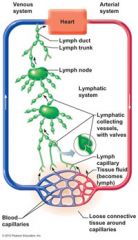
The lymphatic vessels
|

form an elaborate drainage system that picks up the excess tissue fluid, or lymph, leaked from blood in the capillary beds and returns it to the blood. If the fluid is not returned and accumulates in the tissues, edema, or swelling, results. Excessive edema impairs the ability of tissue cells to make exchanges within the interstitial fluid and the blood.
|
|
|
The lymphatic vessels, also called lymphatics
|
form a one-way system, and lymph flows only toward the heart.
|
|
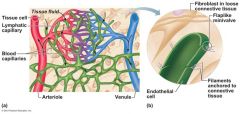
The microscopic, blind-ended lymph capillaries
|

weave between the tissue cells and blood capillaries in the loose connective tissues of the body and absorb the leaked fluid. Lymphatic capillaries are very permeable and have one-way flaps on the end allowing the lymph to enter when the fluid pressure is higher in the interstitial space. When the pressure is higher inside the lymphatic vessels, the flaps are forced together, preventing the lymph from leaking back out and forcing it along the vessel.
|
|
|
lymphatic collecting vessels
|
Lymph is transported from the lymph capillaries through successively larger lymphatic vessels, referred to as lymphatic collecting vessels, until it is returned to the venous system through one of the two large ducts in the thoracic region.
|
|
|
The right lymphatic duct
|
drains the lymph from the right arm and the right side of the head and thorax.
|
|
|
The thoracic duct
|
receives lymph from the rest of the body. Both ducts empty the lymph into the subclavian vein on their own side of the body. Lymphatic vessels are thin walled, and the larger ones have valves. The lymphatic system is a low-pressure, pumpless system, and lymph is transported by the same mechanisms that aid return of venous blood, the milking action of the skeletal muscles, and pressure changes in the thorax during breathing. Smooth muscle in the walls of the larger lymphatics contracts rhythmically, helping to pump the lymph along.
|
|
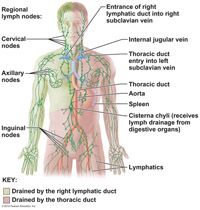
The lymph nodes
|

help protect the body by removing foreign material such as bacteria and tumor cells from the lymphatic stream, and by producing lymphocytes that function in the immune response. As lymph is transported toward the heart, it is filtered through the thousands of lymph nodes that cluster along the lymphatic vessels.
|
|
|
macrophages
|
Within the lymph nodes are macrophages which engulf and destroy bacteria, viruses, and other foreign substances in the lymph before it is returned to the blood.
|
|
|
lymphocytes
|
a type of white blood cell
are also strategically located in the lymph nodes and respond to foreign substances in the lymphatic stream. |
|
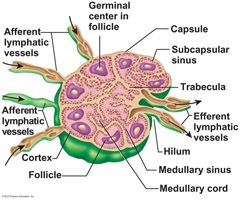
The outer part of the node
|

its cortex, contains collections of lymphocytes.
|
|

Lymph enters the lymph node through
|
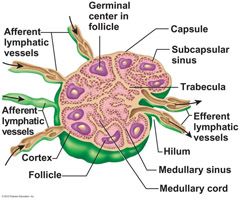
afferent lymphatic vessels.
|
|
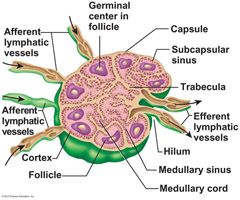
It then flows through a number of...
|
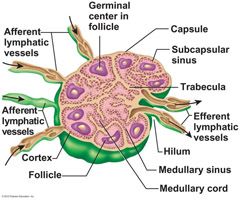
sinuses that meander through the lymph node and finally exits from the node via efferent lymphatic vessels.
|
|
|
Lymph nodes are one of the many types of lymphoid organs in the body...
|
Others are the spleen, thymus, tonsils, Peyer's patches, and the appendix of the intestine.
|
|
|
Lymphoid organs have roles in protecting the body with lympocytes, but...
|
only the lymph nodes filter lymph.
|
|
|
The spleen
|
is a blood-rich organ that filters and cleanses blood of bacteria, viruses, and other debris.
The spleen also provides a site for lymphocyte proliferation and immune surveillance as well as destroying worn-out red blood cells and returning some of their breakdown products to the liver. Other functions of the spleen include storing platelets and acting as a blood reservoir. |
|
|
The thymus
|
which functions at peak levels only during youth, is a lymphoid mass found low in the throat. The thymus produces hormones, thymosin and others, that function in the programming of certain lymphocytes so they can carry out protective roles in the body.
|
|
|
The tonsils
|
are small masses of lymphoid tissue that ring the pharynx. They are found in the mucosa that trap and remove bacteria and other foreign pathogens entering the throat.
|
|
|
Peyer's patches
|
are found in the wall of the distal part of the small intestine. Lymphoid follicles are also heavily concentrated in the wall of the appendix. The macrophages of Peyer's patches and the appendix are in an ideal position to capture and destroy bacteria, thereby preventing them from penetrating the intestinal wall.
|
|
|
immune system
|
The body has two defense systems, the innate and adaptive defense systems, to assist in fighting against foreign invaders
|
|
|
he innate defense system, or the nonspecific defense system
|
responds immediately to protect the body from all foreign substances, and works to prevent entry and spread of microorganisms throughout the body.
|
|
|
The adaptive, or specific defense system
|
mounts the attack against particular foreign substances. When the immune system is operating effectively, it protects from most bacteria, viruses, transplanted organs or grafts, and cancer cells.
The immune system accomplishes this directly by cell attack, and indirectly, by releasing mobilizing chemicals and protective antibody molecules. |
|

The resulting highly specific resistance to disease is called
|
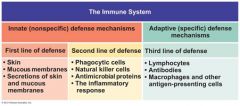
immunity
and the study of immunity is called immunology. The adaptive system must first come into contact with the foreign substance (antigen) before it can protect the body against the invader. |
|
|
Some innate resistance to disease is inherited, but typically innate body defenses refers to the mechanical barriers that cover body surfaces and to the cells and chemicals that act on the initial battlefronts to protect the body from invading pathogens (harmful or disease-causing microorganisms)...
|
The acidic pH of skin secretions and usually of urine inhibits bacterial growth, and sebum contains chemicals that are toxic to bacteria. Vaginal secretions of adult females are also very acidic.
The stomach mucosa secretes hydrochloric acid and protein-digesting enzymes. Both kill pathogens. Saliva and lacrimal fluid contains lysozyme, an enzyme that destroys bacteria. Sticky mucus traps many microorganisms that enter digestive and respiratory passageways. |
|
|
The second line of defense in the body is
|
the internal defenses that include natural killer cells, inflammatory response, phagocytes, antimicrobial proteins, and fever.
|
|
|
Natural killer (NK) cells
|
roam the body in blood and lymph and are a unique group of lymphocytes that can lyse and kill cancer cells, virus-infected body cells, and some other nonspecific targets before the adaptive arm of the immune system is activated.
NK cells attack targets by recognizing certain sugars on the surface of the intruder as well as the lack of certain cell surface molecules. NK cells are not phagocytic, they attack the target cell's membrane and release a lytic chemical called perforins that causes the nucleus to disintegrate. |
|
|
Inflammatory response
|
is a nonspecific response that is triggered when body tissues are injured. Example of injuries include physical trauma, intense heat, irritating chemicals, and infections.
|
|
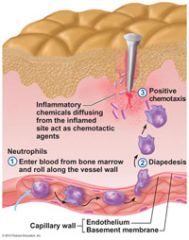
The four most common indicators, or cardinal signs, of an acute inflammation are...
|

redness, heat, swelling, and pain.
|
|
|
Dilation of the blood vessels...
|
increases the blood flow to the area, accounting for the redness and heat observed.
|
|
|
Inflammatory response prevents...
|
the spread of damaging agents to nearby tissues, disposes of cell debris and pathogens, and gets the body ready for repair. Within an hour after injury, neutrophils are devouring any foreign material present.
|
|
|
Monocytes
|
follow the neutrophils into the inflamed area, and within 12 hours after entering the tissue, they become macrophages and take care of the final disposal of cell debris. Clotting proteins, leaked into the area from the blood, are activated and begin to wall off the damaged area to prevent the spread of pathogen agents to neighboring tissues. The local heat increases the metabolic rate of the tissue cells, speeding up their defensive actions and repair processes.
|
|
|
Phagocytes
|
such as macrophages or neutrophils, engulf foreign particles and are found in nearly every body organ. Flowing cytoplasmic extensions bind to the foreign particle and pull it inside where the contents are broken down.
|
|
|
A fever, or abnormally high body temperature
|
is a systemic response to invading microorganisms. The thermostat of the body, located in the hypothalamus, is normally set at approximately 98.6 F.
|
|
|
High fevers are dangerous to the body, but mild or moderate fevers benefit the body because...
|
the liver and spleen gather up iron and zinc. Bacteria need large amounts of iron and zinc to multiply, and they become less available during a fever. A fever also increases the metabolic rate of tissue cells in general, speeding up repair processes.
|
|
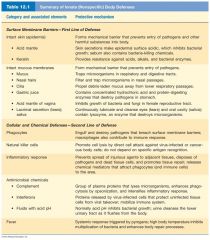
Process review
|
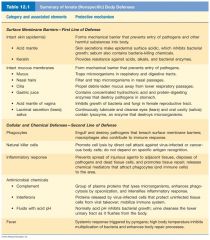
Review process
|
|
|
The adaptive, or specific defense system
|
mounts the attack against particular foreign substances.
|
|
|
The immune systems' response to a threat
|
called the immune response, involves internal nonspecific defenses and also provides protection that is carefully targeted against specific antigens.
|
|
|
The specific defense system is a functional system that recognizes foreign molecules (antigens) and acts to inactivate or destroy the invaders. Three important aspects of the adaptive defense include:
|
The adaptive defense system is antigen specific. It recognizes and acts against particular pathogens (disease-causing organisms) or foreign substances.
The adaptive defense system is systemic. Immunity is not restricted to the initial infection site. The adaptive defense system has memory. It recognizes and mounts even stronger attacks on previously encountered pathogens. |
|
|
An antigen (Ag)
|
is any foreign substance capable of mobilizing the immune system and provoking an immune response. Most antigens are large, complex molecules that are not normally present in the body. The immune system considers them foreign intruders, or nonself.
|
|
|
Every individual's cells have self-antigens that...
|
do not trigger an immune response in that individual, but that do trigger a response in other people. These self-antigens are why cells of transplanted organs or grafts will be rejected unless special measures are taken to cripple or stifle the immune response.
|
|
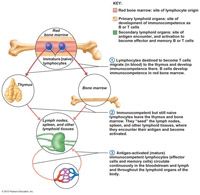
Lymphocytes (a type of white blood cell) are...
|
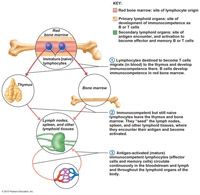
an important cell of the adaptive system and are released from the marrow. A lymphocyte matures into a B cell or a T cell depending on where it matures in the body. T cells arise from lymphocytes that migrate to the thymus. B cells develop in bone marrow. Lymphocytes capable of binding strongly with self-antigens are vigorously weeded out and destroyed.
|
|
|
Humoral immunity
|
is provided by antibodies present in the body's fluids.
|
|
|
active immunity
|
When B cells encounter antigens and produce antibodies against them
|
|
|
Active immunity is acquired during bacterial and viral infections or artificially acquired through...
|
vaccines
|
|
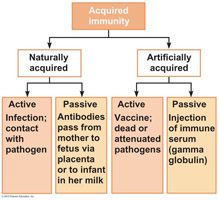
passive immunity
|
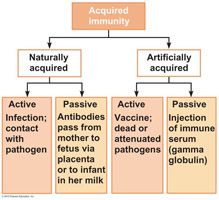
the antibodies are obtained from the serum of an immune human or animal donor. B cells are not challenged by the antigen, and immunological memory does not occur.
Passive immunity is conferred naturally on a fetus when the mother's antibodies cross the placenta. Artificial passive immunity is conferred when a person receives immune serum or gamma globulin. |
|
|
Antibodies are secreted by activated B cells in response to an antigen, and...
|
they are capable of binding specifically with that antigen.
|
|
|
Antibodies are also referred to as immunoglobulins, or Igs...
|
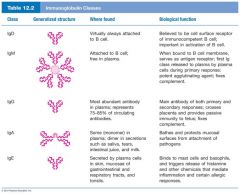
The five Ig classes are outlined.
|
|
|
Antibodies inactivate antigens in a number of ways as outlined...
|
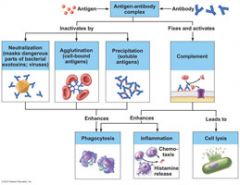
|
|
|
Cellular immunity
|
occurs when lymphocytes themselves defend the body. T cells are not able to bind with free antigens, only antigens that have been presented. Once an antigen has been presented the T cell begins the activation process.
|
|
|
Organ transplants have had mixed success because of the risk of the immune system rejecting the transplant. There are four major types of grafts:
|
Autografts, Isografts, Allografts, Xenografts.
|
|
|
Autografts
|
are tissue grafts transplanted from one site to another in the same person
|
|
|
Isografts
|
are tissue grafts donated by a genetically identical person, an identical twin.
|
|
|
Allografts
|
are tissue grafts taken from a person other than an identical twin.
|
|
|
Xenografts
|
are tissue grafts harvested from a different animal species, such as transplanting a baboon heart into a human being.
|
|
|
After surgery, to prevent rejection, the patient receives...
|
immunosuppressive therapy, including one or more of the following: corticosteroids to suppress inflammation, antiproliferative drugs, radiation therapy, and immunosuppressor drugs.
|
|
|
Occasionally, the immune system can no longer tolerate self-antigens while still recognizing and attacking foreign antigens. When this happens, the body produces antibodies and sensitized T cells that attack and damage its own tissues. This is called...
|
autoimmune disease because a person's immune system produces the disorder
|
|
|
heumatoid arthritis (RA)
|
destroys joints.
|
|
|
Myashenia gravis
|
impairs communication between nerves and skeletal muscles.
|
|
|
Multiple sclerosis (MS)
|
destroys the white matter (myelin sheaths) of the brain and spinal cord.
|
|
|
Graves' disease
|
causes the thyroid gland to produce excessive amounts of thyroxine.
|
|
|
Type 1 diabetes mellitus destroys
|
pancreatic beta cells, resulting in deficient production of insulin.
|
|
|
Systemic lupus erythematosus (SLE)
|
affects the kidneys, heart, lungs, and skin.
|
|
|
Glomerulonephritis
|
causes impairment of kidney function.
|
|
|
Allergies, or hypersensitivities
|
are abnormally vigorous immune responses in which the immune system causes tissue damage as it fights off a perceived threat that would otherwise be harmless to the body.
|
|
|
The most common type of allergy is...
|
immediate hypersensitivity or acute hypersensitivity.
|
|
|
Hypersensitivity is triggered by the release of...
|
a flood of histamine when IgE antibodies bind to mast cells. Histamine causes small blood vessels in the area to become dilated and leaky and results in runny nose, watery eyes, and hives. Allergies are often treated with antihistamines. Asthma symptoms can be caused when an allergen is inhaled.
|
|
|
Severe combined immunodeficiency disease (SCID)
|
is a congenital condition in which there is a marked deficit of both B and T cells. Afflicted children have essentially no protection against pathogens of any type. Bone marrow transplants and umbilical cord blood have helped some SCID victims. Otherwise, those with the disease must live behind protective barriers that keep out all infectious agents.
|
|
|
Acquired immune deficiency syndrome (AIDS)
|
is the most devastating of the acquired immunodeficiencies. AIDS cripples the immune system by targeting and destroying helper T cells, resulting in severe depression of cell-mediated immunity. Without helper T cells, the cytotoxic T cells and B cells cannot be activated or maintained, and the whole immune system does not function correctly.
|

